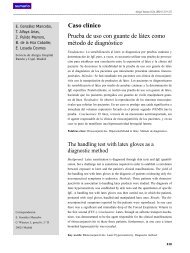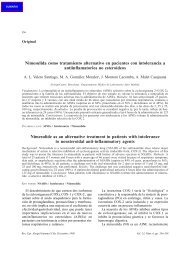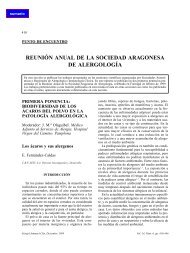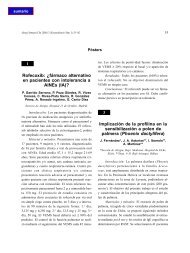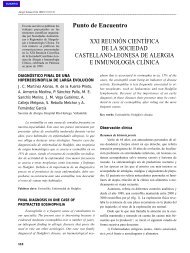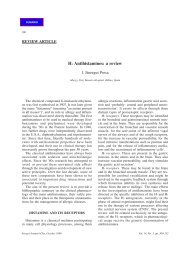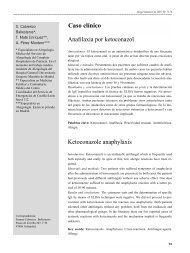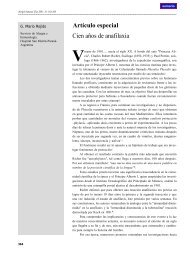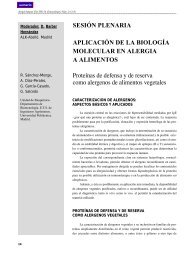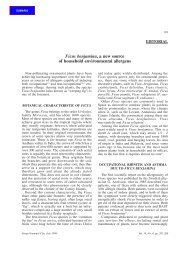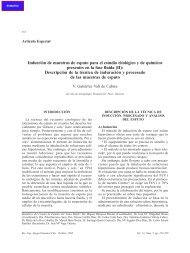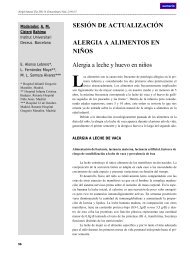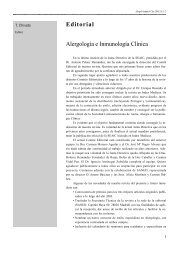Alergol Inmunol Clin 2001; 16: 294-296
Alergol Inmunol Clin 2001; 16: 294-296
Alergol Inmunol Clin 2001; 16: 294-296
You also want an ePaper? Increase the reach of your titles
YUMPU automatically turns print PDFs into web optimized ePapers that Google loves.
<strong>Alergol</strong> <strong>Inmunol</strong> <strong>Clin</strong> <strong>2001</strong>; <strong>16</strong>: <strong>294</strong>-<strong>296</strong><br />
J. M. Vega,<br />
T. Caro-Patón*,<br />
P. Sánchez,<br />
M. E. Sanchís,<br />
C Martínez,<br />
R. de la Fuente,<br />
A. Armentia,<br />
A. Fernández<br />
Allergy Section and<br />
*Pharmacy Service. "Río<br />
Hortega" University Hospital.<br />
Valladolid (Spain).<br />
Correspondence address:<br />
Dr. J. M. Vega<br />
Sección de Alergia<br />
Hospital Río Hortega<br />
Cardenal Torquemada, s/n<br />
E-47010 Valladolid, Spain<br />
<strong>294</strong><br />
Case report<br />
Delayed hypersensitivity reaction<br />
to enoxaparin with sensitisation<br />
to other low-molecular weight and<br />
unfractionated heparins:<br />
tolerance to a recombinant hirudin<br />
The administration of unfractionated heparin (UFH) or of low-molecular weight<br />
heparins (LMWH) may induce a non-necrotic eczematous reaction at the site of<br />
injection that is mediated by a delayed hypersensitivity mechanism. We describe<br />
the case of a 38-year-old woman who, after two episodes of abdominal skin<br />
rash in relation to the administration of enoxaparin, had a negative subcutaneous<br />
challenge test with desirudin, a new recombinant hirudin. In patients evidencing<br />
heparin hypersensitivity, and particularly in those with hypersensitivity<br />
to multiple UFH and LMWH preparations and who require urgent anticoagulation,<br />
recombinant hirudins may represent a safe alternative until allergological<br />
studies can be performed.<br />
Key words: Heparin. Low-molecular weight heparin. Recombinant hirudin.<br />
Allergic reaction.<br />
Reacción de hipersensibilidad retardada<br />
por enoxaparina con sensibilización<br />
a otras heparinas de bajo peso molecular<br />
y no fraccionadas: tolerancia de una<br />
hirudina recombinante<br />
La administración de heparinas no fraccionadas (HNF) o de heparinas de bajo<br />
peso molecular (HBPM) puede ocasionar una reacción eccematosa no necrótica<br />
en el lugar de la inyección, mediada por un mecanismo de hipersensibilidad retardada.<br />
Se describe el caso de una mujer de 38 años que, tras sufrir dos episodios<br />
de erupción cutánea abdominal relacionados con la administración de enoxaparina,<br />
presentó una prueba de provocación cutánea negativa con desirudina,<br />
una nueva hirudina recombinante. En aquellos pacientes que presentan sensibilización<br />
a heparinas, sobre todo cuando es múltiple a HNF y HBPM, en caso de<br />
precisar anticoagulación urgente y a la espera de las pruebas alérgicas las hirudinas<br />
recombinantes pueden constituir una alternativa segura.<br />
Palabras clave: Heparina. Heparina de bajo peso molecular. Hirudina recombinante.<br />
Reacción alérgica.
The administration of unfractionated heparins<br />
(UFH) or of low-molecular weigh heparins<br />
(LMWH) may induce a non-necrotic eczematous<br />
reaction at the site of injection, in which a delayed hypersensitivity<br />
mechanism is involved 1 . Cross-reactivity<br />
has often been observed in these cases between the various<br />
heparins 2-5 or even with heparinoids 3-5 . This may<br />
constitute a problem, particularly when faced with an urgent<br />
need for anticoagulant therapy. There have recently<br />
been reports of cases in which the new recombinant hirudins<br />
represent a safe alternative for patients with this type<br />
of reaction 3,6,7,9 .<br />
CASE REPORT<br />
A 38-year old woman, obese but with no other salient<br />
features in her past history, was referred to the<br />
Allergy Outpatient <strong>Clin</strong>ic because of two episodes of abdominal<br />
skin rash which she described as vesicular-blistering<br />
within the past two years. The first episode had occurred<br />
ten days after the subcutaneous administration into<br />
the abdominal wall of enoxaparin (Clexane ® ) 40 mg, one<br />
dose every 24 hours, because of a tibioperoneal fracture<br />
suffered during a motoring accident. The administration of<br />
this low-molecular weight heparin was continued for five<br />
further days; the skin rash progressed to involve the whole<br />
abdomen, and remitted gradually in a number of days after<br />
withdrawal of the drug. The second episode occurred after<br />
the administration of the same low-molecular weight heparin<br />
because of a new tibial fracture after a further traumatism.<br />
In this case, the skin rash in the abdomen began<br />
several hours after the administration of the first dose and,<br />
as the drug was not immediately withdrawn, progressed to<br />
involve the whole abdomen with greater severity than in<br />
the previous occasion. The rash again remitted gradually<br />
after withdrawal of the drug.<br />
After recovering from this second episode the patient<br />
was seen for the first time at the Allergy Outpatient <strong>Clin</strong>ic,<br />
and the following allergologic study was performed (Table<br />
I): (1) skin prick tests at 1:1 dilution with unfractionated<br />
heparin (heparin sodium) and with two LMWH [enoxaparin<br />
and nadroparin (Fraxiparin ® )], which were read after 20<br />
minutes, 48 hours and 96 hours, and (2) epicutaneous tests,<br />
again at 1:1 dilution, with the same heparin preparations,<br />
which were read after 48 and 96 hours. Positive results were<br />
observed in the epicutaneous tests with all the heparin<br />
preparations used, but the reactions were stronger with the<br />
Delayed hypersensitivity to enoxaparin<br />
Table I. Results of the skin prick and epicutaneous tests and<br />
of the subcutaneous tolerance tests with various heparin<br />
preparations and with desirudin<br />
Prick Epicutaneous Subcutaneous<br />
1:1, 20 min 1:1, 48 h/96 h 1:1, 20 min/48 h<br />
Unfractionated heparin<br />
Heparin sodium<br />
Low-molecular weight heparins<br />
– +/++ NT<br />
Nadroparin (Fraxiparin ® ) – ++/++ NT<br />
Enoxaparin (Clexane ® )<br />
Recombinant hirudin<br />
– +++/+++ NT<br />
Desirudin (Revasc ® )<br />
NT = Not tested.<br />
– – –<br />
LMWH and particularly with enoxaparin (Fig. 1); the parallel<br />
tests in control patients were negative.<br />
The possibility of tolerance to a recombinant hirudin,<br />
desirudin, was considered as two similar case reports were<br />
Fig. 1. Results of the epicutaneous tests with various heparin<br />
preparations (1:1 dilution) at the second reading (96 hours).<br />
295
J. M. Vega, et al<br />
found in the literature with good tolerance to that drug 6,7 .<br />
Skin prick and epicutaneous tests were thereupon performed<br />
with desirudin, with negative results; after the patient<br />
had given her informed consent, a subcutaneous challenge<br />
test with desirudin (Revasc ® , 15 mg) was carried out, with<br />
full tolerance and with no immediate or delayed reaction.<br />
DISCUSSION<br />
Delayed skin reactions in the form of eczematous<br />
plaques at the site of injection of LMWH appear after several<br />
days (3 – 13 days); they are more frequent in obese<br />
women with protracted treatments 5 , as in the present case,<br />
and in diabetics, and they may be more frequent than generally<br />
suspected 3 . Using skin tests (intradermal or epicutaneous)<br />
and skin biopsies, these lesions have been demonstrated<br />
to be consistent with delayed hypersensitivity<br />
reactions, probably elicited by the heparin molecule itself<br />
as most heparin preparations are devoid of conservants 3 .<br />
Various degrees of cross-reactivity have been reported between<br />
the two forms of heparin (UFH and LMWH) and the<br />
heparinoids: only between some LMWH, between LMWH<br />
and UFH, or between heparins and heparinoids 1-9 . In a recent<br />
study on 23 patients with delayed hypersensitivity reactions<br />
to heparins, most were sensitised to both types of<br />
heparins and to heparinoids 3 . Both types of heparins and<br />
daparinoid (a heparinoid type) are derived from the porcine<br />
intestinal mucosa, so that, when it is intended to test<br />
heparinoid tolerance, other alternative drugs are recommended,<br />
even though there have been reports of cases evidencing<br />
cross-reactivity to the latter 3 .<br />
The recombinant hirudin derivatives are polypeptides<br />
acting through direct inhibition of thrombin. Desirudin is<br />
administered subcutaneously for the prophylaxis of postsurgical<br />
deep venous thrombosis. Lepirudin is administered<br />
intravenously, and it has been used in heparin-induced<br />
type II thrombocytopenia and in haemodialysis patients<br />
with heparin-induced necrosis. However, these drugs are<br />
contraindicated during pregnancy and may also trigger immediate<br />
or delayed hypersensitivity reactions, even though<br />
no cross-reactivity has been demonstrated between them<br />
and heparins or heparinoids. Thus, therapy with recombinant<br />
hirudin derivatives may be indicated without awaiting<br />
the results of allergologic studies when the indication for<br />
anticoagulation is urgent 3 .<br />
Delayed hypersensitivity to heparins and heparinoids<br />
may be demonstrated through epicutaneous or intradermal<br />
<strong>296</strong><br />
tests (up to 1:1 dilution) with delayed reading; greater sensitivity<br />
has been observed with the latter 3 , although in that<br />
case positive results were seen with all the heparin preparations<br />
tested epicutaneously. Challenge tests with the alternative<br />
drug(s) are required despite the negativity of the<br />
skin tests.<br />
In the case here reported, tolerance to a recombinant<br />
hirudin was demonstrated in a patient with delayed eczematous<br />
reactions in the area of subcutaneous administration<br />
of enoxaparin, with sensitisation to this LMWH, to<br />
other LMWH and to UFH. This case agrees with previously<br />
published ones of delayed hypersensitivity reactions<br />
to heparins with tolerance to recombinant hirudins<br />
(desirudin 6,7 or lepirudin 3,7 ). In delayed reactions induced<br />
by heparins with evidence of sensitisation to these drugs,<br />
and particularly when the sensitisation is multiple to<br />
LMWH and UFH or when the allergic tests must be postponed<br />
because anticoagulation is urgently required, recombinant<br />
hirudins may represent a safe alternative.<br />
REFERENCES<br />
1. Bircher AJ, Flückinger R, Büchner SA. Eczematous infiltrated plaques<br />
to subcutaneous heparin: a type IV allergic reaction. Br J Dermatol<br />
1990; 123: 507-514.<br />
2. Méndez J, Sanchís ME, de la Fuente R, Stolle R, Vega JM, Martínez<br />
C, et al. Delayed-type hypersensitivity to subcutaneous enoxaparin.<br />
Allergy 1998; 53: 999-1003.<br />
3. Koch P, Munssinger T, Rupp-John C, Uhl K. Delayed-type hypersensitivity<br />
skin reactions caused by subcutaneous unfractionated and<br />
low-molecular-weight heparins: tolerance of a new recombinant hirudin.<br />
J Am Acad Dermatol 2000; 42: 612-619.<br />
4. Sivakumaran K, Ghosh K, Munks R, Gelsthorpe K, Tan L, Wood<br />
JK. Delayed cutaneous reaction to unfractionated heparin, low molecular<br />
weight heparin and danaparoid. Br J Haematol 1994; 86:<br />
893-894.<br />
5. Szolar-Platzer C, Werner A, Kränke B. Delayed-type skin reaction<br />
to heparin-alternative daparinoid. J Am Acad Dermatol 2000; 43:<br />
920-922.<br />
6. Koch P, Reinhold S, Bush C. Delayed allergic skin reactions to<br />
subcutaneous heparins. Tolerance of 2 recombinant hirudins. Contact<br />
Dermatitis 2000; 42: 278-279.<br />
7. Martín L, Machet L, Gironet N, Pouplard C, Gruel Y, Vaillant L.<br />
Eczematous plaques related to unfractionated and low-molecularweight<br />
heparins: cross-reaction with danaparoid but not with desirudin.<br />
Contact Dermatitis 2000; 42: 295-<strong>296</strong>.<br />
8. Méndez J, de la Fuente R, Stolle R, Vega JM, Sanchís ME, Armentía<br />
A, et al. Delayed hypersensitivity skin reaction to enoxaparin.<br />
Allergy 1996; 51: 853-854.<br />
9. Bircher AJ, Itin PH, Tsakiris DA, Surber C. Delayed hypersensitivity<br />
to one low-molecular-weight heparin with tolerance of other lowmolecular-weight<br />
heparins. Br J Dermatol 1995; 132: 461-463.




